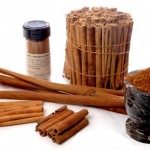 Although the research is far from conclusive, a recently published study has demonstrated that cinnamaldehyde, is the organic compound that gives cinnamon its distinctive flavor and odor, stimulates the release of progesterone decreases the concentration of both Testosterone and dehydroepiandrosterone (DHEA) in human adrenal cells.
Although the research is far from conclusive, a recently published study has demonstrated that cinnamaldehyde, is the organic compound that gives cinnamon its distinctive flavor and odor, stimulates the release of progesterone decreases the concentration of both Testosterone and dehydroepiandrosterone (DHEA) in human adrenal cells.
Life Sci. 2010 Apr 25. [Epub ahead of print]
Selective stimulation by cinnamaldehyde of progesterone secretion in human adrenal cells.Iwaoka Y, Hashimoto R, Koizumi H, Yu J, Okabe T.
Department of Integrated Traditional Medicine, Graduate School of Medicine, University of Tokyo. Hongo7-3-1, Tokyo 113-8655, Japan.
AbstractAIMS: Cinnamon bark has been used to treat menstrual pain and infertility. While several pharmacological studies have suggested anti-inflammatory properties, the mechanisms by which the herb exerts its various activities have not been well understood. Recent reports suggest menstrual distress is related to higher estradiol levels, higher estradiol/progesterone ratios. Cinnamaldehyde, a major active constituent of Cinnamomum cassia has been shown to stimulate cathecholamine release from adrenal glands. The objective of the present study is to examine whether cinnamaldehyde stimulates secretion of progesterone and other steroid hormones in human adrenal cells. MAIN METHODS: Human adrenal cells, H295R were exposed for 24h in a serum-free medium to various concentrations of cinnamaldehyde. Steroid hormones in the cultured medium were measured by a highly sensitive LC-electrospray ionization-tandem mass spectrometry. KEY FINDINGS: Exposure to cinnamaldehyde increased progesterone release in a dose-dependent manner. Testosterone and dehydroepiandrosterone concentrations decreased in the presence of cinnamaldehyde. The release of cortisol or estradiol was not affected by treatment with cinnamaldehyde. cAMP in the cultured medium was increased from 0.06+/-0.0007pmol/ml to 0.12+/-0.0028pmol/ml by exposure to cinnamaldehyde. The addition of isobutylmehtylxanthine, a phosphodiesterase inhibitor, caused a doubling of the amount of cAMP up to 0.397+/-0.036pmol/ml in the presence of cinnamaldehyde. SIGNIFICANCE: These data suggest that cinnamaldehyde selectively induced progesterone production and inhibited production of testosterone and dehydroepiandrosterone in human adrenal cells. Copyright © 2010. Published by Elsevier Inc.
PMID: 20423713 [PubMed – as supplied by publisher]
